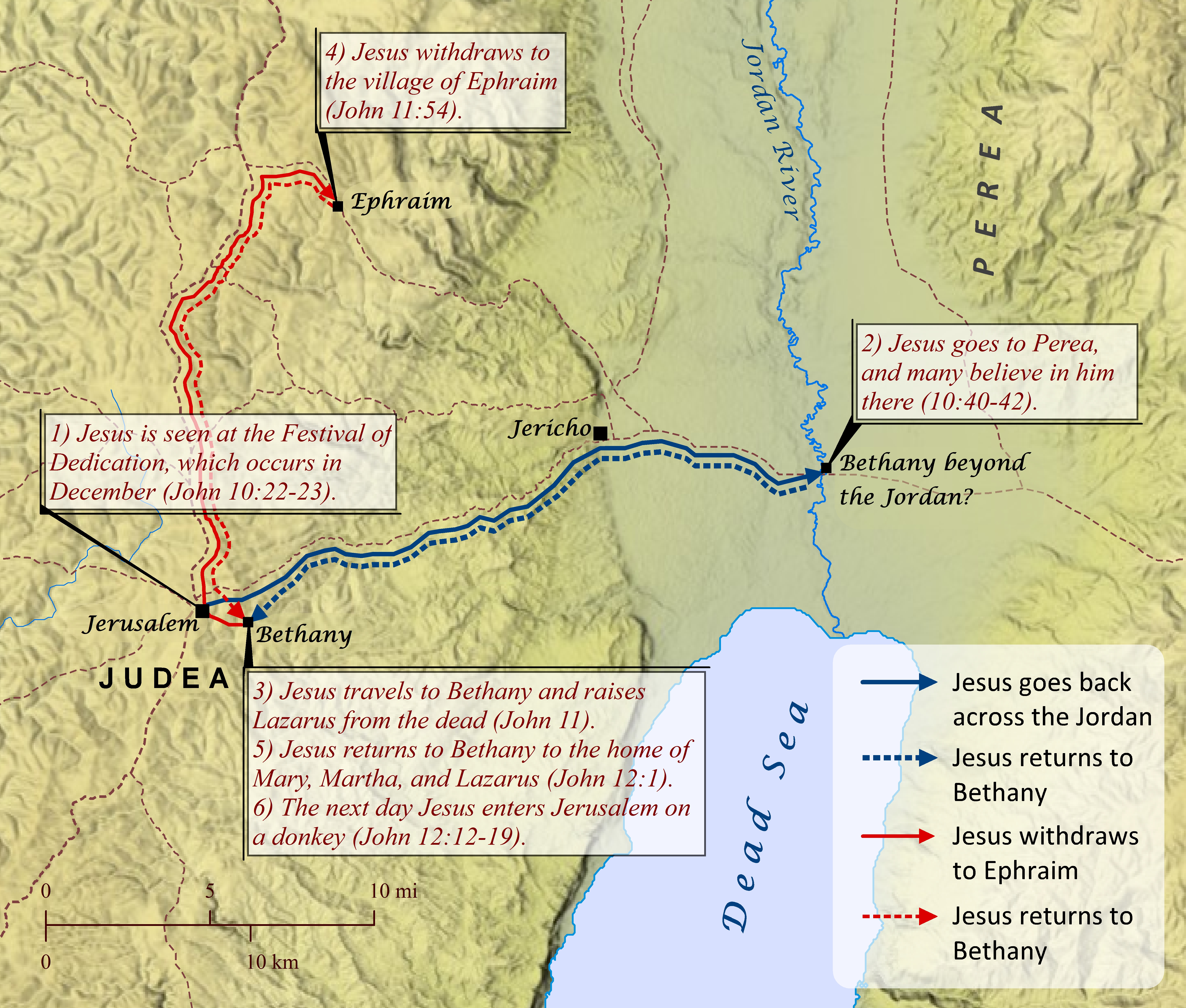Note: This view shows ‘verses’ which are not natural language units and hence sometimes only part of a sentence will be visible—click on any Bible version abbreviation down the left-hand side to see the verse in more of its context. Normally the OET discourages the reading of individual ‘verses’, but this view is only designed as a tool for doing comparisons of different translations—the older translations are further down the page (so you can read up from the bottom to trace the English translation history). The OET segments on this page are still very early looks into the unfinished texts of the Open English Translation of the Bible—please double-check these texts in advance before using in public.
AICNT Now Jesus loved Martha and her sister and Lazarus.
OEB Jesus loved Martha and her sister, and Lazarus.
WEBBE Now Jesus loved Martha, and her sister, and Lazarus.
WMBB Now Yeshua loved Martha, and her sister, and Lazarus.
NET (Now Jesus loved Martha and her sister and Lazarus.)
LSV And Jesus was loving Martha, and her sister, and Lazarus,
FBV Even though Jesus loved Martha, Mary, and Lazarus,
TCNT Now Jesus loved Martha, her sister Mary, and Lazarus.
T4T Jesus loved Martha and her younger sister Mary and Lazarus.
LEB (Now Jesus loved Martha and her sister and Lazarus.)
BBE Now Jesus had love in his heart for Martha and her sister and Lazarus.
Moff [Relocated to follow vs 2] Jesus loved Martha and her sister and Lazarus;
Wymth Now Jesus loved Martha, and her sister, and Lazarus.
ASV Now Jesus loved Martha, and her sister, and Lazarus.
DRA Now Jesus loved Martha, and her sister Mary, and Lazarus.
YLT And Jesus was loving Martha, and her sister, and Lazarus,
Drby Now Jesus loved Martha, and her sister, and Lazarus.
RV Now Jesus loved Martha, and her sister, and Lazarus.
SLT And Jesus loved Martha, and her sister, and Lazarus.
Wbstr Now Jesus loved Martha, and her sister, and Lazarus.
KJB-1769 Now Jesus loved Martha, and her sister, and Lazarus.
KJB-1611 Now Iesus loued Martha, and her sister, and Lazarus.
(Modernised spelling is same as from KJB-1769 above)
Bshps Iesus loued Martha, and her sister, and Lazarus.
(Yesus/Yeshua loved Martha, and her sister, and Lazarus.)
Gnva Nowe Iesus loued Martha and her sister, and Lazarus.
(Now Yesus/Yeshua loved Martha and her sister, and Lazarus. )
Cvdl Iesus loued Martha & hir sister, & Lazarus.
(Yesus/Yeshua loved Martha and her sister, and Lazarus.)
TNT Iesus loved Martha and her sister and Lazarus.
(Yesus/Yeshua loved Martha and her sister and Lazarus. )
Wycl And Jhesus louyde Martha, and hir sistir Marie, and Lazarus.
(And Yhesus loved Martha, and her sister Mary/Maria, and Lazarus.)
Luth JEsus aber hatte Martha lieb und ihre Schwester und Lazarus.
(Yesus but had Martha kind/sweet/dear and their/her sister and Lazarus.)
ClVg Diligebat autem Jesus Martham, et sororem ejus Mariam, et Lazarum.[fn]
(Diligebat however Yesus Martham, and sister his Mariam, and Lazarum. )
UGNT ἠγάπα δὲ ὁ Ἰησοῦς τὴν Μάρθαν, καὶ τὴν ἀδελφὴν αὐτῆς, καὶ τὸν Λάζαρον.
(aʸgapa de ho Yaʸsous taʸn Marthan, kai taʸn adelfaʸn autaʸs, kai ton Lazaron.)
SBL-GNT ἠγάπα δὲ ὁ Ἰησοῦς τὴν Μάρθαν καὶ τὴν ἀδελφὴν αὐτῆς καὶ τὸν Λάζαρον.
(aʸgapa de ho Yaʸsous taʸn Marthan kai taʸn adelfaʸn autaʸs kai ton Lazaron.)
RP-GNT Ἠγάπα δὲ ὁ Ἰησοῦς τὴν Μάρθαν καὶ τὴν ἀδελφὴν αὐτῆς καὶ τὸν Λάζαρον.
(Aʸgapa de ho Yaʸsous taʸn Marthan kai taʸn adelfaʸn autaʸs kai ton Lazaron.)
TC-GNT Ἠγάπα δὲ ὁ Ἰησοῦς τὴν Μάρθαν καὶ τὴν ἀδελφὴν αὐτῆς καὶ τὸν Λάζαρον.
(Aʸgapa de ho Yaʸsous taʸn Marthan kai taʸn adelfaʸn autaʸs kai ton Lazaron. )
Key for above GNTs: yellow:punctuation differs (from our SR-GNT base).
BMM BibleMapper.com Maps:

Jesus’ Final Journey to Jerusalem
Much like the difficulties of discerning the Israelites’ journey to the Promised Land (see here), the task of reconciling the four Gospel accounts of Jesus’ final journey to Jerusalem into one coherent itinerary has proven very challenging for Bible scholars. As with many other events during Jesus’ ministry, the accounts of Matthew, Mark, and Luke (often referred to as the Synoptic Gospels) present a noticeably similar account of Jesus’ final travels, while John’s Gospel presents an itinerary that is markedly different from the others. In general, the Synoptic Gospels present Jesus as making a single journey to Jerusalem, beginning in Capernaum (Luke 9:51), passing through Perea (Matthew 19:1-2; Mark 10:1) and Jericho (Matthew 20:29-34; Mark 10:46-52; Luke 18:35-19:10), and ending at Bethany and Bethphage, where he enters Jerusalem riding on a donkey (Matthew 21:1-11; Mark 11:1-11; Luke 19:28-44). John, on the other hand, mentions several trips to Jerusalem by Jesus (John 2:13-17; 5:1-15; 7:1-13; 10:22-23), followed by a trip to Perea across the Jordan River (John 10:40-42), a return to Bethany where he raises Lazarus from the dead (John 11), a withdrawal to the village of Ephraim for a few months (John 11:54), and a return trip to Bethany, where he then enters Jerusalem riding on a donkey (John 12:1-19). The differences between the Synoptics’ and John’s accounts are noteworthy, but they are not irreconcilable. The Synoptics, after noting that Jesus began his trip at Capernaum, likely condensed their accounts (as occurs elsewhere in the Gospels) to omit Jesus’ initial arrival in Jerusalem and appearance at the Festival of Dedication, thus picking up with Jesus in Perea (stage 2 of John’s itinerary). Then all the Gospels recount Jesus’ trip (back) to Bethany and Jerusalem, passing through Jericho along the way. Likewise, the Synoptics must have simply omitted the few months Jesus spent in Ephraim to escape the Jewish leaders (stage 4 of John’s itinerary) and rejoined John’s account where Jesus is preparing to enter Jerusalem on a donkey.
